
Features
Hatchery Operations
Industry Update
Sustainability
The hatchery industry’s vision for 2024
Reflecting on what’s ahead for the global hatchery industry
January 3, 2024 By Hatchery International
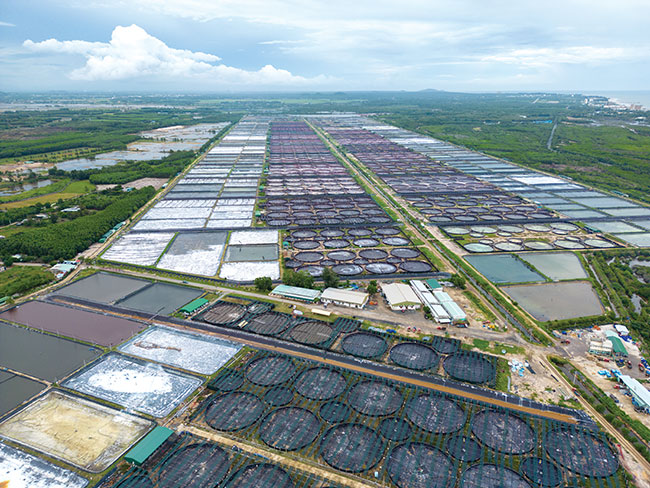 A bird’s eye view of Minh Phu shrimp farm in Loc An, Vietnam.
Photo: The Center for Responsible Seafood
A bird’s eye view of Minh Phu shrimp farm in Loc An, Vietnam.
Photo: The Center for Responsible Seafood The global hatchery industry has austere times ahead.
Inflation and climate change are major themes being felt around the world. Hatchery operators are being faced with economic and ecological challenges that need urgent solutions.
Once again, the editorial team at Hatchery International comes together to take stock of the regions they report from, and bring us a bird’s eye view of the industry’s state of affairs. The goal of this annual outlook is not to discourage those in the industry, but rather embolden experts around the world to share knowledge and collaborate on solutions to the shared challenges that lie ahead.
North America
Some hatcheries in North America are small — like an Ontario community facility that produces “local fish for local lakes” or a Maine shellfish research centre. Others are large enough to support Canada’s global salmon producers or the needs of the U.S. Fish and Wildlife Service to stock for both restoration and recreation. Tribal hatcheries also support fisheries and natural runs where salmon populations have declined.
From size to species to purpose, it’s a big mix that has one element in common: change.
Climate change, in particular, makes it hard to forecast 2024. From floodings to fire, severe weather events threaten infrastructure and the resources that allow hatcheries to operate. Overall, dwindling water supplies are a cause for concern across the continent.
Several hatcheries within New York State’s Department of Environmental Conservation (DEC) rely on surface water but rising water temperatures impact production. As a management action, the DEC is assessing the expanded use of well and spring water, as well as partial water reuse systems, said fisheries biologist, Jim Daley.
Beyond climate change, hatchery managers have much on their minds: coping with inflation and energy costs, attracting staff, dealing with regulations, and adapting business plans.
After delays related to the pandemic and supply chains, Marbase, a startup in Newfoundland and Labrador, decided to diversify species. “The growth cycle of lumpfish is actually shorter than wolffish but the latter is much more valuable, making the economics of our hatchery stronger,” said CEO Paul Antle.
Others are seeking to modernize aging infrastructure and take advantage of new technology. Blair Paul, an algae systems consultant, points to an increase in installations of photobioreactors in some large shellfish hatcheries in Washington and Hawaii. “Oftentimes algae is a limiting part of hatchery work because it’s hard to get enough. [More reliable algae production] will have a big impact on these hatcheries in 2024,” Paul said.
– Lynn Fantom
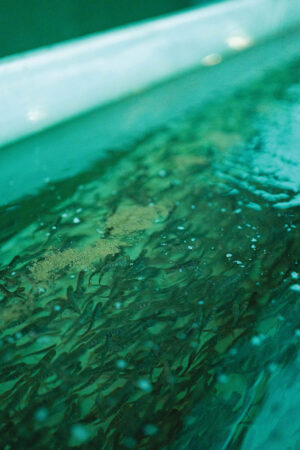
Inflationary costs of fishmeal and fish feed are a major concern for hatchery managers around the world. Photo: Jean Ko Din, Hatchery International
UK & EUROPE
The past year in the U.K. and Europe has been challenging for producers and consumers alike.
Hopes for a peaceful end to the war in Ukraine have proved unfounded, leaving all food producers, including fish farmers, to keep absorbing high energy costs, alongside the continued disruption of raw material supplies.
For consumers, particularly in the U.K., the soaring food price inflation helped trigger a month-by-month rise in interest rates, fuelling a punishing cost-of-living squeeze, which is still impacting many households.
To the credit of fish farmers, however, there are still good signs of progress and persistence.
The latest Scottish Fish Farm Production Survey, for example, was welcomed by Scotland’s Cabinet Secretary for Rural Affairs, Mairi Gougeon, as proof of aquaculture’s significant contribution to the country’s economy. Having generated approximately £885 million (US$1.1 billion) gross value added (GVA) during the survey year, the sector was applauded for the positive impact of its deployment of innovations and new strategies.
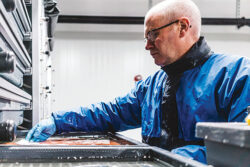
Scottish Sea Farms opened a new incubation facility in Barcaldine, Scotland in September last year. Photo: Scottish Sea Farms
Gougeon also praised producers for enabling a reduction of the country’s reliance on imported salmon ova and for their increase in hatchery output.” This strengthens our domestic supply chain and improves our resilience,” she said.
In the midst of witnessing the volatility of modern aquaculture in Europe, it was good to be able to celebrate one of the industry’s enduring pioneers, Gustavo Larrazábal, who was recognised by the Federation of European Aquaculture Producers (FEAP) as someone who has “skilfully survived” over the past 39 years, the “deadly boom and bust cycles of the Mediterranean sea bass and sea bream sector.”
Recipient of the FEAP Award for 2023, Larrazábal’s career highlights have included heading Aquanaria SL, one of the most successful fish farming companies in Europe, while his company in Northern Spain, previously called Tinamenor SA, was home to one of the first hatcheries of seabass and seabream in Europe.
– Colin Ley
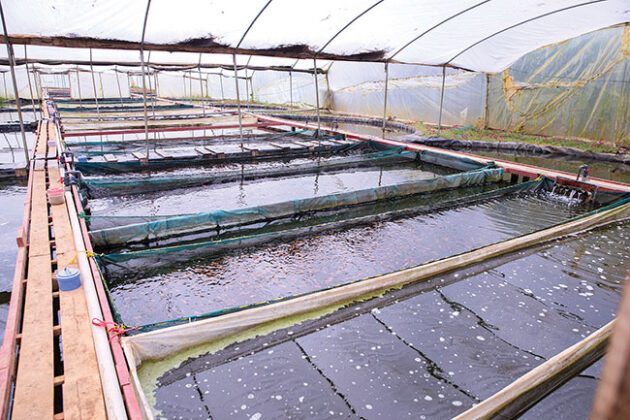
Tilapia farms inside a greenhouse belonging to Lakeside Fish Farm in Bugesera district, Rwanda. (Photo: Bob Atwiine)
AFRICA
For African aquaculture, the year 2024 could remain challenging for fish farmers as they continue to grapple with high prices of fish meal, input costs and high energy prices due to weaker economies coupled with a likelihood of weaker demand as observed in the last year.
High costs of doing business due to inflationary pressures are expected to remain unchanged across Africa because of a stronger dollar playing against most African economies.
During 2023, we have seen that inflation impacted African fish farmers greatly leading to very high prices of fish feeds and making the industry very undesirable. We saw in Ghana, Nigeria, Cameroon, among other countries where fish farmers/producers were severely hit by the effects of high feed prices and energy prices forcing many to close business.
The decrease in fishmeal prices across the continent in real terms is expected to remain insignificant this year due to the ongoing tight supplies and strong demand.
Furthermore, a fish consumption decline is projected in Africa where per capita consumption is the lowest due to increased competition from other meats and other factors compared to the rest of the world.
In the last year, in order to alleviate this challenge, most hatcheries across Africa tried to save money by using lower cost feed quality because the conundrum has been whether to produce or not given the uncertainty in the markers since farmers were not stocking or delaying stocking.
By closely looking at these key issues, Africa’s hatchery industry 2024 outlook paints a gloomy picture and thus requires hatchery owners to quickly adapt to the demands and costs of doing business to stay afloat.
Genetics and breeding companies must also look at the year ahead and discuss issues that directly affect hatcheries and the role of genetics in the current context.
Facilitating a greater exchange of knowledge between the rest of the world and Africa can improve the capabilities of both, with training and education programs, technical assistance, mentoring and coaching all ways to improve the skills of local actors in the sector. Investing in African aquaculture is not just about unlocking a new borderline with enormous potential, but it is also about addressing the pressing challenges of today.
– Bob Atwiine
EAST EUROPE
Rabid inflation makes the lives of fish farmers across Eastern Europe challenging, as customers find themselves under pressure to revise their budgets.
In 2022, fish consumption in Poland, the largest market in Eastern Europe, dropped by eight per cent compared with the previous year, owing to a population’s weak purchasing power and soaring prices, a study conducted by Bank Ochrony rodowiska showed.
Currently, Poles consume 12-13 kilograms of fish per capita, and both customers and fish farmers expressed concerns over the carp market situation in the Christmas season, according to local press. Carp is a traditional Christmas dish in Poland, though last year, the price spiked to PLN 65 (US$15.6) per kilogram of fillet, or almost a quarter.
This year, the price is not expected to go further up, Andrzej Dmuchowski, vice-president of Polski Karp, assured.
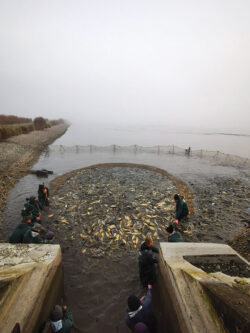
Although breeding costs increased, retail prices will remain at last year’s level, said Andrzej Dmuchowski, vice-president of Polski Karp. (Photo: Polski Karp)
“Although breeding costs increased, retail prices will remain at last year’s level,” Dmuchowski said, adding that cheap grain helped farmers stick to the same price tags.
In the meantime, there is no confidence among Polish carp breeders that consumption will be high this year, as customers have to better plan their expedites.
In other countries of Eastern Europe, the picture is similar. The annual consumption of freshwater fish in Slovakia currently is as low as one kilogram per capita, Michal Madžunkov, president of the Association of Fish Breeders in Slovakia.
Last year, carp prices jumped by 18 per cent, weighing heavily on consumption. Currently, Slovak fish farmers try to encourage citizens to eat more fish, including by offering to purchase carp directly from the farm. However, the demand has yet to bounce back.
Seafood consumption in Europe has fallen 27 per cent in the past six years, according to the European Fish Processors and Traders Association.
– Vlad Vorotnikov
SOUTHEAST ASIA
Indonesia and the Philippines, international leaders in farmed seafood production, have similar production forecasts as well as challenges for this year. Governments are stepping in to do their share.
Indonesia is batting for over 10 per cent growth in annual aquaculture output volume. Its blue economy is propped by five species: shrimp, lobster, crab, tilapia, and seaweed.
One of the major challenges cited by the government is the provision of quality seeds.
The government is pinning hopes on a national seed network to improve the quality of broodstock candidates, broodstock and fish seeds. More than coming up with quality seeds, the network aims to produce “an effective, efficient and comprehensive seed and brood stock provision logistics ecosystem that aligns with decision-making both at the central and regional levels.”
Meanwhile, it has set up Smart Fisheries Villages, most of these located in Java. It is an innovative and holistic approach aiming for the sustainability of small stakeholders. The concept includes the application of high-quality seeds, information and communication technology, proper management, sustainability, and economic growth in line with the aquaculture village program and Innovation Village/Partner Village.
The Philippine government has allocated a budget of P6.9 billion (US$123 million) to the National Fisheries Program “to elevate the standard of agri-fishery practices, product quality as well as farmers and fisherfolk’s income.”
There is a separate budget of P211 million (US$3.8 million) for the Boosting Aquaculture Production program to support a 10 per cent increase target in fish production.
Like the situation in Indonesia, seed supply is also a challenge in the Philippines. Sen. Cynthia Villar says the answer lies in the establishment of more hatcheries.
Through the Committee on Agriculture, Food and Agrarian Reform, which she chairs, 23 government-funded multi-species hatcheries are targeted to be completed in different municipalities throughout the country in 2024.
Villar has been emphasizing the importance of having more hatcheries to ease dependence on imported fingerlings and provide access to small players. She specifically cited fingerlings like milkfish, tilapia, mangrove crabs, pompano, shrimp, and grouper.
Dependable supply of locally produced fry and fingerlings is critical to sustaining the aquaculture industry. Per Philippine Statistics Authority data, farmed seafood accounted for over 54 per cent of the country’s total fisheries production in 2022.
– Ruby Gonzalez
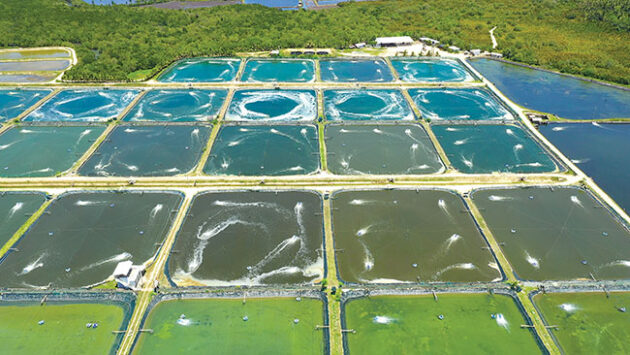
Indonesia and the Philippines governments are stepping in to do their share to boost its blue economies.
(Photo: Alexpunker/iStock/Getty Images Plus/Getty Images)
AUSTRALIA
With the El Niño Southern Oscillation (ENSO) turning to the dry, El Niño cycle, coupled with a positive Indian Ocean Dipole (IOD), the Australian continent can expect the climate over the next 18 months, or more, to be drier and hotter than the long-term average.
This is the polar opposite to the last three years during which extreme rain events caused major flooding, but cooler and more stable water temperatures.
The impact of these conditions on hatchery operators, depending on the time of the spawning cycle, will vary. Apart from the obvious threats from bushfires, drought, and water conditions reaching upper critical limits, extreme heat waves place an enormous burden on the power grid.
With Australia transitioning from a fossil fuel-powered electricity grid to a sustainable alternative energy source, many of the older coal-powered generators have become uneconomical and have been decommissioned.
Others, ironically some of the newer installations, have suffered rolling outages. Power companies have expressed concerns there may be times when the power supply cannot keep up with demand.
The hatchery operators whom Hatchery International spoke with said they were well equipped to generate emergency power should this happen, and were confident blackouts wouldn’t be a problem.
Most barramundi and all salmon spawnings are carried out in insulated, climate-controlled recirculating systems and juvenile seedstock are produced around the calendar. Barramundi are spawned on a lunar cycle and salmon broodstock are conditioned for autumn and spring smolt stockings.
Mussel and flat oyster spawnings are carried out during the cooler months, and hatchery operators feel confident they can manage any unseasonal temperature spikes that may occur.
Structural changes, coupled with production issues at some rock oyster hatcheries meant spat supply in the 2022/23 season fell short of grower demand. That, coupled with unexplained mortality events in Pacific oyster stock in NSW tested many growers.
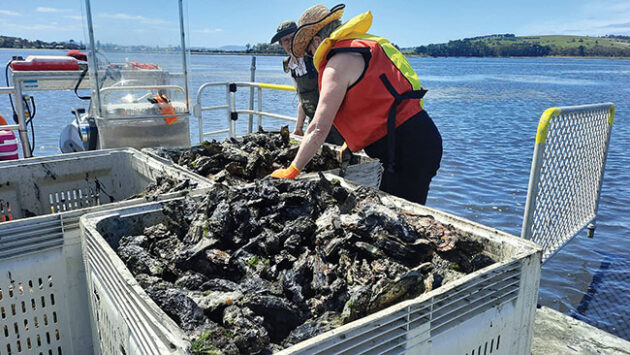
John Ramsden, hatchery manager at Tasmanian Oyster Company, feels the availability of a healthy number of mature broodstock is meeting current demand.
Photo: Tasmanian Oyster Company
John Ramsden, hatchery manager at Tasmanian Oyster Company, feels the availability of a healthy number of mature broodstock is meeting current demand. However, while above-average winter water temperatures have led to higher growth rates, with an El Niño warning in place for the 2023/24 season, hatcheries are preparing spawners as best they can for heatwave conditions.
As native freshwater species (Murray cod, jade, and silver perch) are traditionally raised to juvenile size from induced hatchery spawnings and in open larval rearing ponds over late winter to early spring, pond temperature spikes are rarely a problem. In fact, they can boost plankton production and advance growth rates.
The Australian hatchery sector is experienced and, in the main, prepared for hostile weather conditions. As with all commercial enterprises, it’s dependent on the viability of its clientele: the growout sector. This base, except for the RAS farms, is facing production problems associated with an El Niño cycle.
Also, being at the higher end of the animal protein shopping list, consumer choices during any cost-of-living crunch may affect sales. Both the growout and hatchery sectors are confident Australia’s growing demand for fresh seafood will outstrip supply for some time.
– John Mosig
Print this page
Advertisement
- Conservation partnership releases Arctic grayling into Michigan lakes
- EU project explores toxic pufferfish for aquaculture feed





